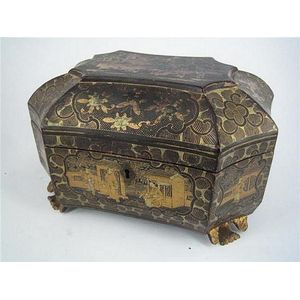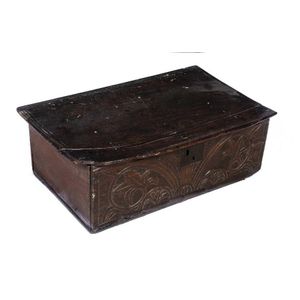Rosewood Tea Caddy and Walnut Stationery Stand
You must be a subscriber, and be logged in to view price and dealer details.
Subscribe Now to view actual auction price for this item
When you subscribe, you have the option of setting the currency in which to display prices to $Au, $US, $NZ or Stg.
- Regency Period - The Regency period in English furniture design refers to the period when King George III, was declared unfit to rule in 1811, and his son ruled as proxy as Prince Regent, until 1820, and then, after the death of his father as George IV until his death in 1830. The Regency period was preceded by the Georgian period (George I, George II, and George III: 1714 - 1811), and was followed by the William IV period, which only lasted until 1837 when William IV died as was succeeded by Queen Victoria.
- Rosewood - A dense timber that varies in shade to very light brown to almost black. When rosewood is cut and sanded the colour of the timber will turn black, and after polishing and exposure to daylight, the surface will gradually lighten over time to light brown with black streaks.
The name comes from the odour emanating from the timber when it is planed, sanded or cut.
Rosewood was very popular for use in Victorian furniture in the second half of the 19th century, and at that time most of the rosewood was imported from Brazil. However it also grows in India and Indonesia.
It is used in the sold for chairs and table legs, but for carcase furniture such as side cabinets and bookcases, and for table tops it is always used as a veneer. - Burr - Burr (or in the USA, burl) is the timber from the knotted roots or deformed branch of the tree, which when cut, displays the small circular knots in various gradations of colour. It is always cut into a decorative veneer, most commonly seen as burr walnut on 19th century furniture.
This item has been included into following indexes:
- letter racks - various materials 21
- tea caddies, material
- tea caddies, period or age - Regency 146
Visually similar items

A 19th century Chinese black lacquer and gilt tea caddy, the casket with in-curved foliage and figure decorated panels; pewter fitted interior; carved gilt feet. Width 23 cm

Regency rosewood sarcophagus tea caddy with double lidded interior and turned carrying handles

A quality Chinese dark green Hotien carved jade seal, the turtle-dragon with snake wrapped to his body surmounts the large green seal block, a stylised scrolling dragon to each side, four dominant characters to the base, near uniform dark green tone, finel

An oak carved deed box, English, late 17th/18th century, 23 cm high, 69 cm wide, 43 cm deep
